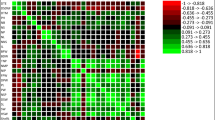Abstract
To study the genetic variation, heritability and genetic correlations of some agro-morphological traits in tall fescue, 25 parents from a genetically broad-base germplasm were polycrossed and their respective half-sib families were generated. Clonally propagated parents and their half-sib families were grown as spaced single plants using a randomized complete-block design with three replications, and observed for seven traits in 2006 and 2007. The estimates of broad-sense heritability \( \left( {h^{2}_{\text{n}} } \right) \) were moderate to high \( \left( {h^{2}_{\text{b}} \, = \, 0.43\, - \,0.80} \right) \) for the traits studied. Narrow-sense heritability \( \left( {h^{2}_{\text{n}} } \right) \) estimates from analyses of progenies and from regression of half-sib (HS) progenies on parents \( \left( {h^{2}_{\text{op}} } \right) \) suggested that genetic variation for these traits was largely controlled by additive gene action. Association of dry matter yield (DMY) with plant height, number of fertile shoot, curbs width and spring growth was positive and significant. With the exception of number of days to pollination, correlation coefficients of the traits between the parents and offspring were not significant. Based on parent-offspring regression, genetic gain from selection for DMY was high, demonstrating genetic potential for improving this trait. Overall, there was high genetic variation and moderate heritability for most traits in the tall fescue populations evaluated. In conclusion, to improve herbage yield, selection would be more effective based on forage yield components.
Similar content being viewed by others
References
Aastiveit AH, Aastiveit K (1990) Theory and application of open pollination and polycross in forage grass. Theor Appl Genet 79:618–624
Barker RE, Kalton KK (1989) Cool season forage grass breeding: progress, potentials, and benefits. In: Sleper DA, Assay KH, Pedersen JF (eds) Contribution from breeding forage and turf grasses, Crop Science Society of America. CSSA Special Publication, Madison, pp 5–20
Berdahl JD, Barker RE (1997) Clonal and open-pollinated progeny testing in an intermediate wheatgrass population. Crop Sci 37:1751–1754
Buckner RC (1985) The fescues. In: Heath ME, Barnes RF, Metcalf DS (eds) Forages: the science of grassland agriculture. Iowa State University Press, Iowa, pp 233–240
Burton G (1989) Progress and benefits to humanity from breeding warm-season forage grasses. In: Sleper DA, Assay KH, Pedersen JF (eds) Contribution from breeding forage and turf grasses, Crop Science Society of America. CSSA Special Publication, Madison, pp 5–20
Burton G, De Vane EH (1953) Estimating heritability in tall fescue (Festuca arundinacea) from replicated clonal material. Agron J 45:478–481
Comstock RE, Robinson HF (1952) Genetic parameters, their estimation and significance. In: Proceedings of the 6th International Grasslands Congress, Pennsylvania State College, USA, pp 284–291
De-Araujo MRA, Coulman BE (2002) Genetic variation, heritability and progeny testing in meadow bromegrass. Plant Breed 121:417–427. doi:10.1046/j.1439-0523.2002.739124.x
Dudley JW, Moll RH (1969) Interpretation and use of estimates of heritability and genetic variances in plant breeding. Crop Sci 9:257–262
Elgersma A (1990) Heritability estimates of spaced–plant traits in three perennial rye grass (Lolium prenne L.). Euphytica 51:163–171
Falconer D (1989) Introduction to quantitative genetics, 3rd edn. Longman, New York
Hovin AW, Marten GC, Stucker RE (1976) Cell wall constituents of reed canarygrass: genetic variability and relationship to digestibility and yield. Crop Sci 16:575–578
Jauhar PP (1975) Genetic control of chromosome pairing in polyploid fescues: its phylogenetic and breeding implications. In: Report of the welsh plant breeding station for 1974, Wales, UK, pp 114–127
Kanapeckas J, Tarakanovas P, Lemeþiene A (2005) Variability, heritability and correlations of genetic resources in meadow fescue. Biol J 3:10–14
Kempthorne O (1957) An introduction to genetic statistics. Wiley, New York
Khayam-Nekouei M, Mirlohi AF, Naderi-Shahab M, Meon S, Ali AM, Napis S (2000) Genetic diversity of tall fescue in Iran. In: Proceeding of the 4th national congress on genetics, Genting Highlands, pp 60–68
Majidi MM, Mirlohi AF, Sayed-Tabatabaei BE (2006) AFLP analyses of genetic variation in Iranian fescue accessions. Pak J Biol Sci 9:1869–1876
Meyer WA, Funk CR (1989) Progress and benefits to humanity from breeding cool-season grasses for turf. In: Sleper DA, Assay KH, Pedersen JF (eds) Contribution from breeding forage and turf grasses, Crop Science Society of America, vol 15. CSSA Special Publication, Madison, pp 31–48
Miller PA, Williams JC, Robinson HF, Comstock RE (1958) Estimates of genotypic and environmental variances and co-variances in upland cotton and their implications in selection. Agron J 50:126–131
Nguyen HT, Sleper DA (1983a) Theory and application of half-sib mating in forage grass breeding. Theor Appl Genet 64:187–196. doi:10.1007/BF00303763
Nguyen HT, Sleper DA (1983b) Genetic variability of seed yield and reproductive characters in tall fescue. Crop Sci 23:621–626
Piano E, Annicchiarico P, Romani M, Pecetti L (2008) Genetic variation and heritability of forage yield in Mediterranean tall fescue. Plant Breed 126:644–646. doi:10.1111/j.1439-0523.2007.01416.x
SAS Institute (1988) SAS/STAT user’s guide. Release 6.03. SAS Institute, Cary
Schiller JMA, Lazenby A (1975) Yield performance of tall fescue (Festuca arundinacea) lines at Canberra. A.C.T. Aust J Exp Agric Anim Husb 15:391–399. doi:10.1071/EA9750391
Sleper DA (1985) Breeding tall fescue. Plant Breed Rev 3:313–342
Sleper DA, West CP (1996) Tall fescue. In: Moser LE et al (eds) Cool season forage grasses. Agron. Monoger. ASA, CSSA and SSSA, Madison, pp 471–502
Sprague GF, Eberhart SA (1977) Corn breeding. In: Sprague GF (ed) Corn and corn improvement. American Society of Agronomy, Madison, pp 305–362
Wilkins PW (1985) Breeding for dry matter yield in perennial ryegrass by wild hybridization and recurrent selection. In: Proceeding of the 2th EUCARPIA Fodder Crop Meeting, Savalo
Wricke G, Weber WE (1986) Quantitative genetics and selection in plant breeding. Walter de Gruyter, New York, p 406
Author information
Authors and Affiliations
Corresponding author
Rights and permissions
About this article
Cite this article
Majidi, M.M., Mirlohi, A. & Amini, F. Genetic variation, heritability and correlations of agro-morphological traits in tall fescue (Festuca arundinacea Schreb.). Euphytica 167, 323–331 (2009). https://doi.org/10.1007/s10681-009-9887-6
Received:
Accepted:
Published:
Issue Date:
DOI: https://doi.org/10.1007/s10681-009-9887-6




